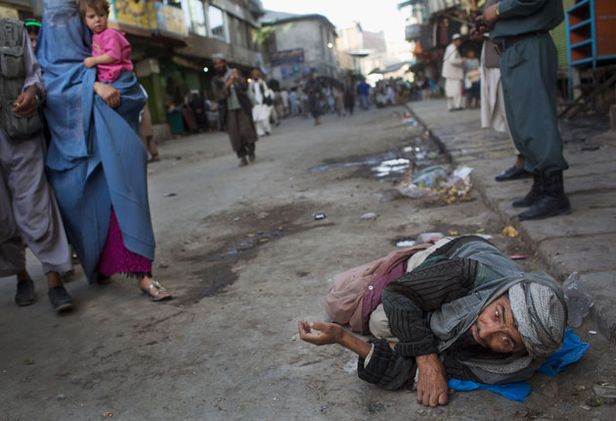A beggar in Kabul; as winter approaches, half of Afghans may not get enough to eat, the US Famine Early Warning Systems Network says. Photo: Getty
By Patrick Cockburn, The Independent, Dec. 13, 2010
The most extraordinary failure of the US-led coalition in Afghanistan is that the expenditure of tens of billions of dollars has had so little impact on the misery in which 30 million Afghans live. As President Barack Obama prepares this week to present a review of America’s strategy in Afghanistan which is likely to focus on military progress, US officials, Afghan administrators, businessmen and aid workers insist that corruption is the greatest threat to the country’s future.
In a series of interviews, they paint a picture of a country where $52bn (£33bn) in US aid since 2001 has made almost no impression on devastating poverty made worse by spreading violence and an economy dislocated by war. That enormous aid budget, two-thirds for security and one-third for economic, social and political development, has made little impact on 9 million living in absolute poverty, and another 5 million trying to survive on $43 (£27) a month. The remainder of the population often barely scrapes a living, having to choose between buying wood to keep warm and buying food.
Afghans see a racketeering élite as the main beneficiaries of international support and few of them are optimistic about anything changing. “Things look all right to foreigners but in fact people are dying of starvation in Kabul,” says Abdul Qudus, a man in his forties with a deeply lined face, who sells second-hand clothes and shoes on a street corner in the capital. They are little more than rags, lying on display on the half-frozen mud.
“I buy and sell clothes for between 10 and 30 Afghanis (two to six cents) and even then there are people who are too poor to buy them,” says Mr Qudus. “I myself am very poor and sometimes I don’t eat so I can feed my children.” He says he started selling second-hand clothes two years ago when he lost his job washing carpets.
The aid projects that are meant to help people like Mr Qudus may have little to do with his problems and may not even exist. Fake photographs are often the only evidence that companies have carried out expensive projects located in parts of Afghanistan too dangerous for donors to visit.
“I went to see a food processing plant in the east of the country which was meant to employ 250 women,” says an Afghan who used to work for an American government aid organisation. “We had started the project and were paying for the equipment and the salaries. But all I found was a few people working on a vegetable plot the size of a small room.”
When he complained he was told by a local official to keep his mouth shut. He said that “if I did not keep quiet there would be trouble on the road back to Jalalabad – in other words they would kill me.”


